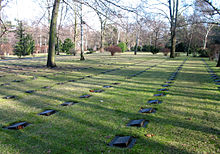Lilienthalstrasse cemetery (Berlin)
The new location cemetery Lilienthalstrasse in Berlin-Neukölln was built from 1938 to 1941 for fallen soldiers of the Wehrmacht . Today 4935 victims of the Second World War rest there in individual graves (soldiers, civilians, bomb victims). Countless war dead rest in collective graves on an area of 1432 square meters. There are regular funerals in the north-eastern sections these days.
History and meaning
The Army Construction Office was responsible for the planning and implementation. The Evangelical Field Bishop of the Wehrmacht inaugurated the cemetery on May 10, 1940.
“The funeral procession should leave the realm of the world and life through a massive, yet delicate gate, climb up a few steps to the monumental celebration hall, the temple of the fatherland, built from ashlars, the interior of which is illuminated from above Closed off from the surrounding everyday life, receives its light from higher regions, opens up to the spiritual realm, as it were. The entire system is strictly symmetrical. The blocky nature of the exterior architecture as well as the unsurpassable simplicity (but not sober) of the interior agree both with the architectural views of the early romantic period and with the previous phase in Büning's work, albeit under significantly changed conditions. A so-called Nazi building that actually isn't, or, if you want, the only one that wasn't artistically unsuccessful. "
Transfer, burial and grave maintenance were taken over by the Wehrmacht. From April 1941 burials were chargeable. More and more civilians were killed in the Allied air raids on Berlin and were buried in the Lilienthalstrasse cemetery. Unlike originally planned, it was no longer the central Berlin war court of honor.
The Volksbund Deutsche Kriegsgräberfürsorge and the Senate of West Berlin agreed in October 1950 on the Lilienthalstrasse cemetery as the central war cemetery in Berlin. On the eve of the day of national mourning , the Volksbund organized a memorial service there. It has been framed by the Bundeswehr in terms of protocol since the mid-1990s , and today it has an international character thanks to military attachés and other representatives from foreign embassies .
Since 2011, the Nike association has also been using the cemetery for events and exhibitions to strengthen German-Polish relations.
Furnishing
The celebration hall was designed by the architect Wilhelm Büning . In 1966 a cube was built into the outside staircase , which can be understood as the crypt of the celebration hall. This initially contained the “oak wreath” by Ludwig Gies from the Neue Wache . After this in the 2004 German Historical Museum has been spent, the space now houses the sculpture caring wife of Fritz Cremer .
See also
Web links
Individual evidence
- ↑ a b c Berlin Neukölln Lilienthalstrasse (Volksbund Deutsche Kriegsgräberfürsorge)
- ↑ Evangelical Field Bishop of the Wehrmacht (Federal Archives)
- ^ Klaus Konrad Weber, Peter Güttler, Ditta Ahmadi (eds.): Berlin and his buildings. Part X Volume A: Facilities and structures for supply (3) Funeral services. Verlag von Wilhelm Ernst & Sohn, Berlin 1981, ISBN 3-433-00890-6 , p. 64 ff.
- ^ Reservists Association Berlin
- ↑ NIKE Polish Entrepreneurship e. V. ( Memento of the original from June 2, 2014 in the Internet Archive ) Info: The archive link was inserted automatically and has not yet been checked. Please check the original and archive link according to the instructions and then remove this notice. , website
Coordinates: 52 ° 29 ′ 11.2 " N , 13 ° 24 ′ 37.1" E



